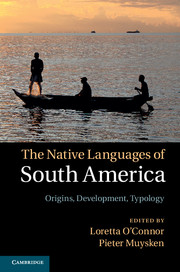
- Cited by 5
-
Cited byCrossref Citations
This Book has been cited by the following publications. This list is generated based on data provided by Crossref.
2015. Publications Received. Language in Society, Vol. 44, Issue. 5, p. 753.
Mihas, Elena 2015. Landscape terms in Alto Perené Kampa (Arawak) of Peru. Acta Linguistica Hafniensia, Vol. 47, Issue. 2, p. 101.
Epps, Patience and Michael, Lev 2017. The Cambridge Handbook of Areal Linguistics. p. 934.
van Gijn, Rik Hammarström, Harald van de Kerke, Simon Krasnoukhova, Olga and Muysken, Pieter 2017. The Cambridge Handbook of Areal Linguistics. p. 964.
Overall, Simon E. Vallejos, Rosa and Gildea, Spike 2018. Nonverbal Predication in Amazonian Languages. Vol. 122, Issue. , p. 1.
- Publisher:
- Cambridge University Press
- Online publication date:
- March 2014
- Print publication year:
- 2014
- Online ISBN:
- 9781107360105
- Subjects:
- Area Studies, Latin American Language and Linguistics, Latin American Studies, Evolution of Language, Language and Linguistics




